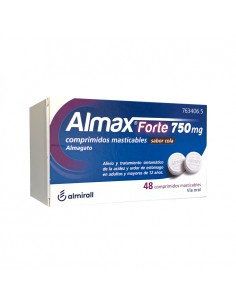Omeprazole Viatris 20 Mg 14 Capsules
1. What Omeprazole Viatris is and what it is used for
Omeprazole Viatris contains the active substance omeprazole. It belongs to a group of medicines called 'proton pump inhibitors'. These medicines work by reducing the amount of acid produced by the stomach.
Omeprazole is used to treat the following conditions:
In adults:
"Gastro-oesophageal reflux disease" (GORD). In this condition, acid from the stomach passes into the oesophagus (the tube that joins the throat to the stomach), causing pain, swelling and burning.
ulcers in the upper part of the intestine (duodenal ulcer) or in the stomach (gastric ulcer).
ulcers infected by a bacterium called "Helicobacter pylori". If you have this disease, your doctor may also prescribe antibiotics to treat the infection and allow the ulcer to heal.
Ulcers caused by medicines called NSAIDs (non-steroidal anti-inflammatory drugs). Omeprazole may also be used to prevent ulcers from forming if you are taking NSAIDs.
Excess acid in the stomach caused by a tumour in the pancreas (Zollinger-Ellison syndrome).
In children:
Children over 1 year of age and ≥ 10 kg.
"Gastro-oesophageal reflux disease (GORD). In this disorder, acid from the stomach passes into the oesophagus (the tube that connects the throat to the stomach), causing pain, swelling and burning.
In children, symptoms of the disease may include the backflow of stomach contents into the mouth (regurgitation), vomiting and poor weight gain.
Children over 4 years of age and adolescents
Ulcers infected by a bacterium called "Helicobacter pylori". If your child has this condition, your doctor may also prescribe antibiotics to treat the infection and allow the ulcer to heal.
2. What you need to know before you start taking Omeprazole Viatris
Do not take Omeprazole Viatris
If you are allergic (hypersensitive) to omeprazole or any of the other ingredients of this medicine (listed in section 6).
If you are allergic to medicines containing proton pump inhibitors (e.g. pantoprazole, lansoprazole, rabeprazole, esomeprazole).
If you are taking a medicine containing nelfinavir (used for HIV infection).
Do not take omeprazole if you are any of the above. If you are not sure, talk to your doctor or pharmacist before taking Omeprazole Viatris.
Warnings and precautions
Ask your doctor or pharmacist before you start taking Omeprazole Viatris:Serious adverse skin reactions including Stevens-Johnson syndrome, toxic epidermal necrolysis, drug reaction with eosinophilia and systemic symptoms (DRESS) and acute generalised exanthematous pustulosis (AGEP) have been reported in association with omeprazole treatment. Stop taking omeprazole and consult your doctor immediately if you experience any of these symptoms related to the serious adverse skin reactions described in section 4.
Omeprazole may mask the symptoms of other diseases. Therefore, if you experience any of the following conditions before you start taking omeprazole or during treatment, consult your doctor immediately:
You lose a lot of weight for no apparent reason and have trouble swallowing.
You have stomach pain or indigestion.
You start vomiting food or vomiting blood.
Your stools are black (blood-tinged stools).
You have severe or persistent diarrhoea, as omeprazole has been associated with a slight increase in infectious diarrhoea.
You have severe liver problems.
If you have ever had a skin reaction after treatment with an omeprazole-like medicine to reduce stomach acid.
You are scheduled to have a specific blood test (Chromogranin A).
When taking omeprazole, inflammation of the kidney may occur. Signs and symptoms may include decreased urine volume or blood in the urine and/or hypersensitivity reactions such as fever, rash and stiff joints. You should report these signs to the doctor treating you.
If you take omeprazole for a long period of time (more than 1 year) you will probably be checked regularly by your doctor. You should report any new or unusual symptoms and circumstances whenever you visit your doctor.
Taking a proton pump inhibitor such as omeprazole, especially for a period of more than one year, may slightly increase the risk of fracturing your hip, wrist or spine. Tell your doctor if you have osteoporosis or if you are taking corticosteroids (which may increase the risk of osteoporosis).
If you develop a rash, especially on sun-exposed areas of skin, consult your doctor as soon as possible, as it may be necessary to stop taking omeprazole. Remember to mention any other symptoms you may notice, such as joint pain.
Children
Some children with chronic diseases may require long-term treatment, although this is not recommended. Do not give the medicine to children under 1 year of age or <10kg in weight.
Other medicines and Omeprazole Viatris
Tell your doctor or pharmacist if you are taking, have recently taken or may need to take any other medicines, including medicines obtained without a prescription. Omeprazole may affect the mechanism of action of some medicines and some medicines may affect omeprazole.
Do not take omeprazole if you are taking a medicine containing nelfinavir (used to treat HIV infection).
Tell your doctor or pharmacist if you are taking any of the following medicines:
Ketoconazole, itraconazole, posaconazole or voriconazole (used to treat fungal infections).
Digoxin (used to treat heart problems).
Diazepam (used to treat anxiety, to relax muscles or in epilepsy).
Phenytoin (used in epilepsy). If you are taking phenytoin, your doctor will need to monitor you when you start or finish treatment with omeprazole.
Medicines used to prevent blood clots, such as warfarin or other vitamin K antagonists. Your doctor will need to monitor you when you start or finish treatment with omeprazole.
Rifampicin (used to treat tuberculosis).
Atazanavir (used to treat HIV infection).
Tacrolimus (in cases of organ transplantation).
St. John's wort (Hypericum perforatum) (used to treat mild depression).
Cilostazol (used to treat intermittent claudication).
Saquinavir (used to treat HIV infection).
Clopidogrel (used to prevent blood clots (thrombi).
Erlotinib (used to treat cancer).
Methotrexate (chemotherapy medicine used in high doses to treat cancer) - if you are taking a high dose of methotrexate, your doctor will have to temporarily stop your omeprazole treatment.
If your doctor, in addition to omeprazole, has prescribed the antibiotics amoxicillin and clarithromycin to treat ulcers caused by Helicobacter pylori infection, it is very important that you inform him/her of the other medicines you are taking.
Taking Omeprazole Viatris with food and drink
You can take your capsules with food or on an empty stomach (see section 3).
Pregnancy and breast-feeding
If you are pregnant or breast-feeding, think you may be pregnant or intend to become pregnant, consult your doctor or pharmacist before using this medicine.
Omeprazole passes into breast milk but is not likely to affect the baby when therapeutic doses are used.
Your doctor will decide whether you can take omeprazole if you are breast-feeding.
Driving and using machines
Omeprazole is not likely to affect your ability to drive or use tools or machines. Side effects such as dizziness and visual disturbances may occur (see section 4). If these occur, you should not drive or use machines.
Omeprazole Viatris contains sucrose and sodium
This medicine contains sucrose. If you have been told by your doctor that you have an intolerance to certain sugars, consult your doctor before taking this medicine.
This medicine contains less than 1 mmol of sodium (23 mg) per dose unit, i.e. essentially "sodium-free".
3. How to take Omeprazole Viatris
Follow your doctor's instructions exactly how to take this medicine. If you are in any doubt, ask your doctor or pharmacist again.
Your doctor will tell you how many capsules to take and for how long you should take them. This will depend on your condition and your age.
The recommended dose is described below.
Adult use:
Treatment of symptoms of GORD, such as heartburn and acid regurgitation:
If your doctor finds that you have mild damage to your oesophagus, the recommended dose is 20 mg once a day for 4-8 weeks. Your doctor may prescribe a dose of 40 mg for another 8 weeks if the oesophagus has not yet healed.
The recommended dose after the oesophagus has healed is 10 mg once a day.
If there is no damage to the oesophagus, the recommended dose is 10 mg once daily.
Treatment of ulcers of the upper part of the intestine (duodenal ulcer):
The recommended dose is 20 mg once daily for 2 weeks. Your doctor may prescribe the same dose for another 2 weeks if the ulcer has not yet healed.
If the ulcer has not healed completely, the dose may be increased to 40 mg once a day for 4 weeks.
Treatment of stomach ulcers (gastric ulcer):
The recommended dose is 20 mg once a day for 4 weeks. Your doctor may prescribe the same dose for another 4 weeks if the ulcer has not healed.
If the ulcer has not healed completely, the dose may be increased to 40 mg once daily for 8 weeks.
Prevention of recurrence of stomach and duodenal ulcers:
The recommended dose is 10 mg or 20 mg once daily. Your doctor may increase the dose to 40 mg once a day.
Treatment of stomach and duodenal ulcers caused by NSAIDs (non-steroidal anti-inflammatory drugs):
The recommended dose is 20 mg once daily for 4-8 weeks.
Prevention of stomach and duodenal ulcers during NSAID administration:
The recommended dose is 20 mg once daily.
Treatment of ulcers caused by Helicobacter pylori infection and prevention of recurrence:
The recommended dose is 20 mg omeprazole twice daily for one week.
Your doctor will also instruct you to take two of the following antibiotics: amoxicillin, clarithromycin and metronidazole.
Treatment of excess acid in the stomach caused by a tumour in the pancreas (Zollinger-Ellison syndrome):
The recommended dose is 60 mg a day.
Your doctor will adjust the dose depending on your needs and will also decide how long you have to take the medicine.
Use in children and adolescents:
Treatment of symptoms of GORD, such as heartburn and acid regurgitation.
Children over one year of age who weigh more than 10 kg can take omeprazole. The dose for children is based on body weight and the doctor will decide the correct dose.
Treatment of ulcers caused by Helicobacter pylori infection and prevention of recurrence:
Children over 4 years of age can take omeprazole . The dose for children is based on body weight and the doctor will decide the correct dose.
The doctor will also prescribe two antibiotics for your child, amoxicillin and clarithromycin.
How to take this medicine
It is recommended to take the capsules in the morning.
You can take your capsules with food or on an empty stomach.
Swallow the capsules whole with half a glass of water. Do not chew or crush the capsules, as they contain coated granules that prevent the medicine from being broken down by stomach acid. It is important not to damage the granules.
What to do if you or your child has trouble swallowing the capsules
If you or your child has trouble swallowing the capsules:
Open the capsules and swallow the contents directly with half a glass of water or pour the contents into a glass of still water, an acidic fruit juice (e.g. apple, orange or pineapple) or applesauce.
Always shake the mixture just before drinking (the mixture will not be clear). Then drink the mixture immediately or within 30 minutes.
To make sure you have taken all of the medicine, fill the glass half full with water, rinse it well and drink the water. The solid parts contain the medicine; do not chew or crush them.
If you take more Omeprazole Viatris than you should
If you have taken more omeprazole than prescribed by your doctor, contact your doctor or pharmacist immediately. You can also call the Poisons Information Service, telephone number 91 562 04 20, stating the medicine and the amount taken.
If you forget to take Omeprazole Viatris
If you miss a dose, take it as soon as you remember. However, if there is not much time left for the next dose, skip the missed dose. Do not take a double dose to make up for a missed dose.
If you stop taking Omeprazole Viatris
Do not stop taking omeprazole without first talking to your doctor or pharmacist.
If you have any other questions about the use of this medicine, ask your doctor or pharmacist.
4. Possible side effects
Like all medicines, this medicine can cause side effects, although not everybody gets them.
If you notice any of the following rare (may affect up to 1 in 1,000 people) or very rare (may affect up to 1 in 10,000 people) but serious side effects, stop taking Omeprazol Viatris and seek medical advice immediately:
Sudden wheezing (sudden wheezing), swelling of the lips, tongue and throat or body, skin rash, fainting or difficulty swallowing (severe allergic reaction) (rare).
Reddening of the skin with blistering or peeling. Severe blistering and bleeding from the lips, eyes, mouth, nose and genitals may also occur. This may be "Stevens-Johnson syndrome" or "toxic epidermal necrolysis". (very rare)
Widespread rash, high body temperature and swollen lymph nodes (DRESS syndrome or drug hypersensitivity syndrome) (rare).
A widespread, red, scaly rash with bumps under the skin and blisters accompanied by fever. Symptoms usually appear at the start of treatment (acute generalised exanthematous pustulosis). (rare)
Yellowing of the skin, dark urine and tiredness, which may be symptoms of liver problems (rare).
Adverse effects may occur with certain frequencies, which are defined as follows:
Very common:
May affect more than 1 in 10 people.
Frequent:
May affect up to 1 in 10 people
Rare:
May affect up to 1 in 100 people
Rare:
May affect up to 1 in 1,000 people
Very rare:
May affect up to 1 in 10,000 people
Not known:
Cannot be estimated from available data.
Other adverse effects are:
Common adverse effects
Headache.
Effects on stomach or intestine: diarrhoea, stomach pain, constipation and gas (flatulence).
Nausea or vomiting.
Benign polyps in the stomach.
Rare side effects
Swelling of the feet and ankles.
Sleep disturbances (insomnia).
Dizziness, tingling sensation, drowsiness.
Feeling of spinning (vertigo).
Changes in blood tests used to check liver function.
Skin rash, itching and rashes.
Feeling of general malaise and lack of energy.
Rare side effects
Blood problems, such as a decrease in white blood cells or platelets. This can cause weakness or bruising and increase the chance of getting infections.
Low sodium concentration in the blood. May cause weakness, vomiting and cramps.
Agitation, confusion or depression.
Taste alterations.
visual problems, such as blurred vision
Sudden feeling of shortness of breath (bronchospasm).
dry mouth
inflammation of the inside of the mouth
Infection called 'candidiasis' which can affect the intestine and is caused by a fungus.
hair loss (alopecia)
Skin rash on exposure to sunlight.
Joint pain (arthralgias) or muscle pain (myalgias).
Severe kidney problems (interstitial nephritis).
Increased sweating.
Very rare side effects
Blood count changes, such as agranulocytosis (lack of white blood cells).
Aggressiveness.
Seeing, feeling or hearing things that are not there (hallucinations).
Severe liver problems leading to liver failure and swelling of the brain.
erythema multiforme
muscle weakness
Enlarged breasts in males.
Adverse effects of unknown frequency
Inflammation in the bowel (causing diarrhoea).
If you are taking omeprazole for more than three months, your blood magnesium levels may decrease. Low magnesium levels may manifest as fatigue, involuntary muscle contractions, disorientation, seizures, dizziness or increased heart rate. If you have any of these symptoms, tell your doctor immediately. Low magnesium levels can also lead to a reduction in potassium or calcium levels in the blood. Your doctor may decide to carry out regular blood tests to monitor your magnesium levels.
Rash, possibly with joint pain.
In very rare cases Omeprazole Viatris may affect the white blood cells in your blood and lead to immunodeficiency. If you are suffering from an infection with symptoms such as fever with a severely deteriorated general condition or fever with symptoms of local infection, such as pain in the neck, throat or mouth or difficulty urinating, you should consult your doctor as soon as possible for a blood test to rule out a lack of white blood cells (agranulocytosis). It is important that you provide information about the medicine you are taking at that time.
Reporting side effects
If you experience any side effects, please tell your doctor, pharmacist or nurse, even if they are not listed in this leaflet. You can also report them directly to the Spanish Pharmacovigilance System for Medicinal Products for Human Use: https://www.notificaram.es. By reporting adverse effects you can help to provide more information on the safety of this medicine.
5. Storage of Omeprazole Viatris
Keep out of the sight and reach of children.
Do not use this medicine after the expiry date which is stated on the carton after EXP or EXP. The expiry date is the last day of the month indicated.
For blister packs: Do not store above 25ºC.
For HDPE bottles: No special storage conditions are required.
Medicines should not be disposed of down the drain or in the trash. Please dispose of containers and medicines that you do not need at the SIGRE Point at the pharmacy. If in doubt, ask your pharmacist how to dispose of packaging and medicines you no longer need. In this way, you will help to protect the environment.
6. Package contents and additional information
Composition of Omeprazole Viatris
The active substance is omeprazole. Omeprazole Viatris contains 20 mg of omeprazole.
The other ingredients (excipients) are: sugar spheres (sucrose, maize starch), methacrylic acid and ethyl acrylate copolymer, hypromellose, disodium phosphate dihydrate, talc, triethyl citrate, titanium dioxide (E-171). Capsules: gelatin, titanium dioxide (E-171) and black printing ink (containing shellac, potassium hydroxide (E-525) and iron oxide black (E-172)).
Appearance of the product and contents of the package
Omeprazole Viatris 20 mg capsules consist of a white body marked 20 and a white cap marked OM.
Pack sizes:
PVC/PVdC-Alu blister with 28 capsules.
White HDPE bottle with screw cap containing 28 or 56 capsules. The cap contains a desiccant capsule with silica gel to protect the capsules from moisture.























